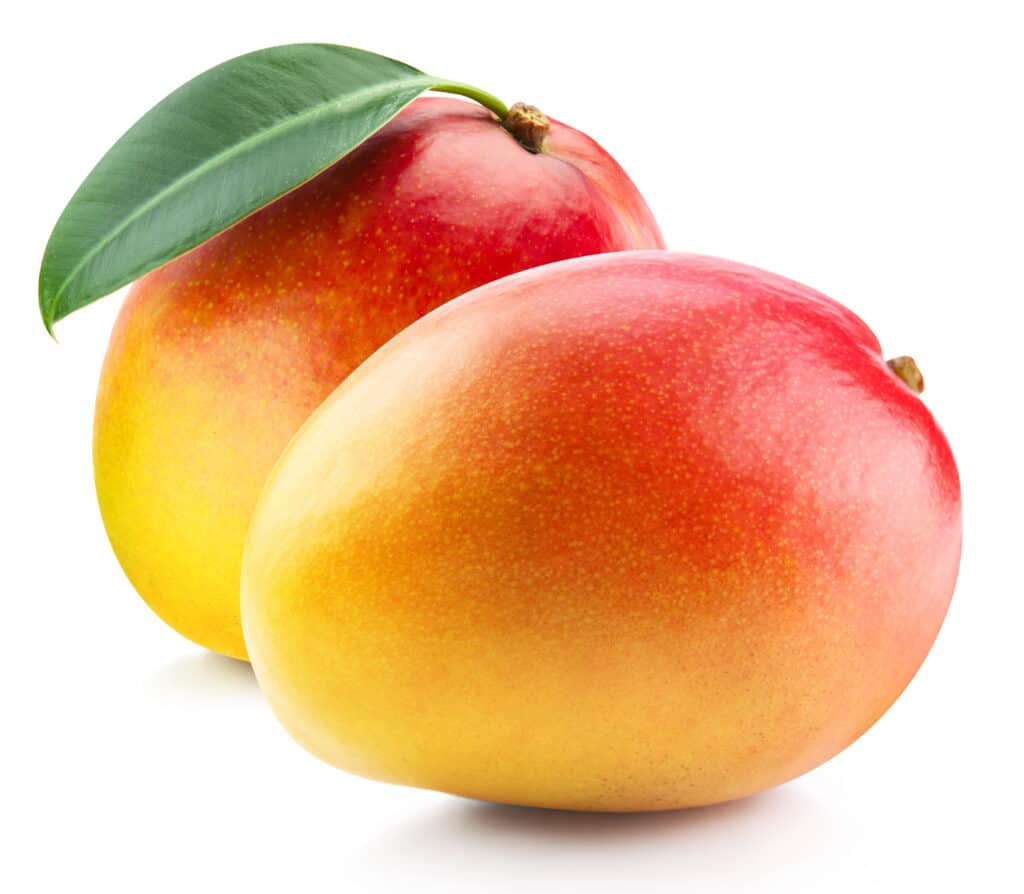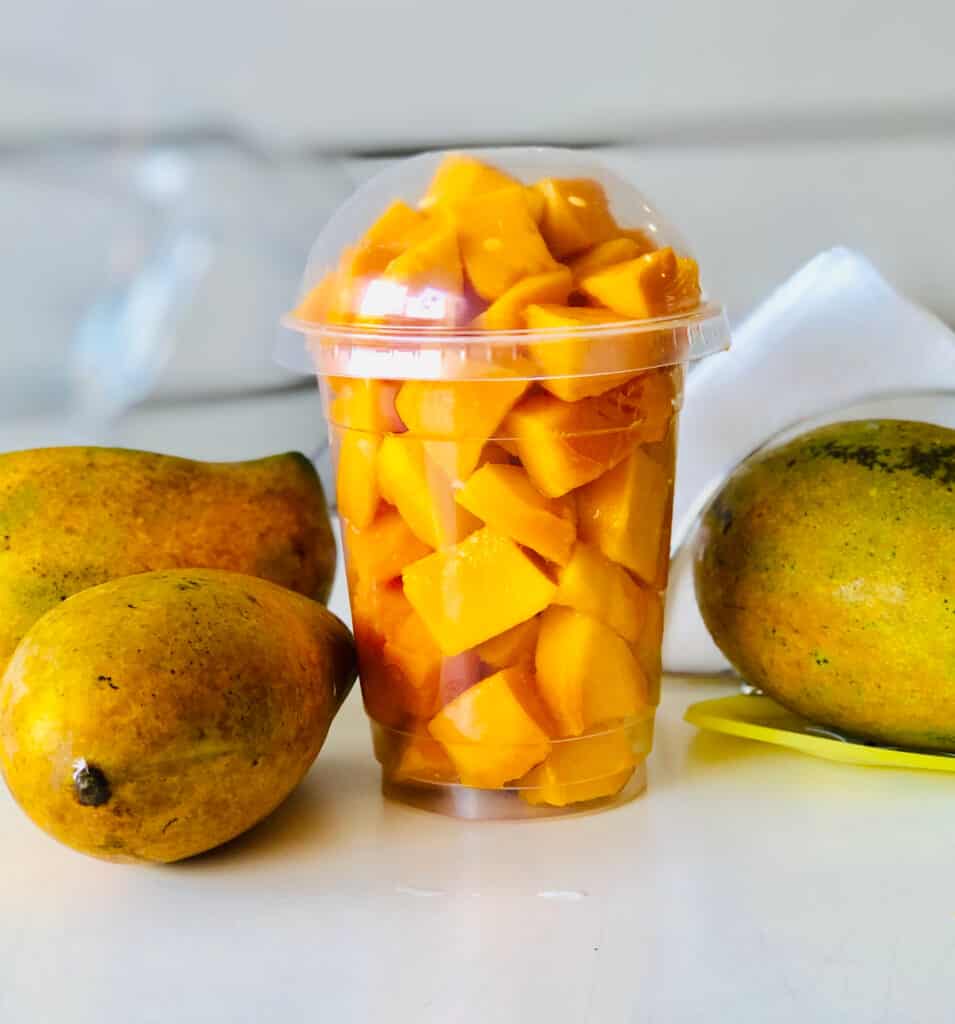Just like humans, many dogs love to have various types of fruits as snacks or treats, so It’s important to know which ones are safe to feed your dog. Fortunately, dogs can have mangos and they make a very healthy treat, as they’re a great source of vitamins. However, you will need to be mindful of how much you feed your dog and which parts of the fruit are safe to give him. Read on to learn more.
Are Mangos Healthy for Dogs?
Yes, mangos make great, healthy treats for dogs. The sweet fruit is full of vitamins, minerals. antioxidants, dietary fiber, and protein that all go in to support good health in dogs. Let’s take a look at some of the health benefits of mangos for dogs:
- Vitamin A: This promotes good eyesight in dogs, which is especially important for senior dogs. It helps in the prevention of developing cataracts, and assists with night blindness and dry eyes. Vitamin A also helps keep your dog’s skin healthy and its coat shiny. It also aids in the proper functioning of the liver, kidneys, and lungs.
- Antioxidants: These help boost your dog’s immune system and defends against degenerative diseases, allergies, skin problems, as well as certain types of cancer.
- Dietary Fiber: This works to keep your dog’s digestive system functioning properly and ensures that everything runs smoothly throughout their digestive tract. It also helps alleviate symptoms of diarrhea and constipation whenever your dog has an upset stomach.
- Protein: Mangos contain protein which helps repair your dog’s muscles and other important body tissues.
- Potassium: This helps to keep your dog’s nerves and muscles functioning properly, and mangos are rich in potassium.
A single mango can contain up to 5 grams of dietary fiber, which may help ease digestive issues. Remember though, you don’t want to give your dog an entire mango in a day, as this can be too much. Start small by giving him a few pieces to see how he handles it.
Mangos also contain amylase which helps break down complex starches. They are an excellent source of several important vitamins, including B6, C, and K. They also contain the antioxidants Mangiferin, beta-carotene, and benzoic acid, which are just a few of the many antioxidants that your pet will receive from consuming mangos. Antioxidant are an important part of both dogs’ and humans’ health, as they work to protect the body’s cells from free radicals and have been shown to prevent cancers, diabetes, and other chronic diseases.
Mangos are also an excellent way to help keep your dog hydrated during the hot summer months. A single mango is roughly 83% water making it a great way to rehydrate and reduce the chances of your dog suffering from heat exhaustion or heat stroke. These are just a few of the many reasons why mangos make a great, healthy treat for dogs.

Mangos are full of vitamins and antioxidants that dogs can benefit from.
©Maks Narodenko/Shutterstock.com
How Much Mango Can Dogs Eat?
Your dog is able to eat one-quarter cup of fresh mango once per week (or twice per week for large dogs). This is an appropriate amount to feed your dog in order to prevent diabetes and obesity. Mangos do contain higher amounts of sugar and have more calories than some fruits, so it’s important that you give them to your dog in moderation. One cup of mango contains 99 calories and 22.5 g of sugar. Although sugar from fruit is okay to have in moderation, having too much of it can still lead to adverse health effects.
If your dog has too much mango in an excessive quantity, he might end up with an upset stomach due to the fruit’s high fiber content. Dietary fiber is very beneficial to have, but only in moderation. Having too much of it can result in diarrhea. As a general rule of thumb, treats like mango should account for no more than 10% of your dog’s daily caloric intake.
It is also very important to keep in mind that some dogs can be allergic to mango, so you should always start out by feeding them small amounts of the fruit to see how they handle it. That way you can confirm there are no side effects due to allergies. Ultimately, it will be up to your vet to determine how many mangos you can feed your dog based on its size, weight, and medical history.

One cup of mango contains approximately 99 calories and 22.5 grams of sugar. It’s recommended dogs not exceed one quarter of this per week.
©Pramodi Kaushalya/Shutterstock.com
How to Feed Dogs Mango
Let’s take a look at some of the steps to take in order to feed your dog mango:
- First, be sure to wash the outside of the mango thoroughly. This will remove any dirt from the fruit and ensure that its safe, and clean before you peel it.
- Next, peel the skin from the fruit
- Remove the large central pit from the fruit, this can pose as a choking hazard for your dog.
- Slice the fruit in small pieces according to your dog’s size. For smaller dogs, cut the fruit into bite sized pieces in order to prevent choking hazards. Bigger dogs can eat larger slices of the fruit since mango flesh is very soft and easy to swallow.
You can also put some of the fruit into a blender and puree it. You can combine this with a small amount of cottage cheese to help alleviate a dog’s upset stomach. Or you could add some of the pieces to your dog’s usual healthy dog food for added health benefits as well as a boost of hydration. You can also freeze it with water in an ice cube tray and then serve it later as a refreshing summer treat for your dog when the weather is warm.
Note: Be sure that you never feed your dog mangos that have gone bad. Rotten fruits contain ethanol (alcohol), which is particularly poisonous to dogs. Some symptoms of alcohol poisoning in dogs includes vomiting, tremors, and seizures which would require immediate veterinary attention.

You can put mango in a blender to puree it for your dog.
©Khanthachai C/Shutterstock.com
Can Dogs Eat Dried Mango?
Dried mangos tend to be very high in sugar, calories, and carbohydrates. The process of drying the fruit also removes some of the fruits original health benefits that it would have had in its fresh state. Small amounts of dried mango won’t do any harm to your dog, but when possible, you should stick with the fresh variety. Having too much dried mango can cause your dog to have an upset stomach, as well as increased risk of tooth decay. This could lead to expensive dog teeth cleaning costs later down the road. If your dog tends to have a sensitive stomach, you can try out a dog food that’s made specifically for sensitive digestion.
Are Mangos Bad for Dogs?
As we’ve shown, mangos make excellent sources of vitamins and nutrients that can be very beneficial for your dog. But it is important to note that there are some cases in which mangos can be bad for dogs and it’s important to be aware of them. Keep a close eye out for any of the following conditions in which mangos can be bad for dogs:
- Mangoes can be bad for dogs that suffer from certain medical conditions like pancreatitis or diabetes. This is because dogs that have these conditions have very specific dietary requirements in order to stay healthy. If your pet has an underlying health condition, you’ll want to speak with your vet first before feeding your dog mangos.
- The skin of the mango is bad for dogs and should not be consumed. This is because it contains urushiol2 which is a component that is found in poison ivy and poison oak. This means it is possible that the skin of the fruit can cause a rash if it comes in contact with your pup’s skin. Mango skin is also incredibly difficult to chew and digest which could lead to an upset stomach, vomiting, or a blockage in the intestines. If this happens you will need to seek immediate medical attention for your dog.
- The mango pit is bad for dogs as it presents a large choking hazard. If your dog manages to swallow the pit of a mango, it may get stuck in its throat or stomach and cause serious, life-threatening issues due to blockage and obstruction.

Mango pits present a choking hazard to dogs so be sure to remove them.
©Peter Zijlstra/Shutterstock.com
What to Do in Case of an Obstruction
If you suspect that your dog has swallowed a mango pit or the skin, you will need to check for clinical signs of a blockage which include:
- Diarrhea
- Abdominal pain
- Vomiting
- Lethargy
- Decreased appetite
- Difficulty breathing
- Stomach bloat
- Constipation
Some of these symptoms can be fatal if left untreated, so it’s important to act fast if you happen to notice any of these signs within your dog’s behavior. You will need to seek emergency veterinarian help so that they can act to clear the blockage right away. If you are unsure if your dog has eaten a mango pit but you notice these symptoms, you should still get your dog to the vet as quickly as possible.
The vet may advise diagnostic tests like x-rays and a physical exam. If your dog eats some of the mango skin, you do not have to be concerned right away. Just keep as close eye on them to see if they begin to display any of the above symptoms. If they do, then you can get in touch with your vet for further instructions.
The photo featured at the top of this post is © Ankit98/Shutterstock.com
Ready to discover the top 10 cutest dog breeds in the entire world?
How about the fastest dogs, the largest dogs and those that are -- quite frankly -- just the kindest dogs on the planet? Each day, AZ Animals sends out lists just like this to our thousands of email subscribers. And the best part? It's FREE. Join today by entering your email below.
Thank you for reading! Have some feedback for us? Contact the AZ Animals editorial team.







